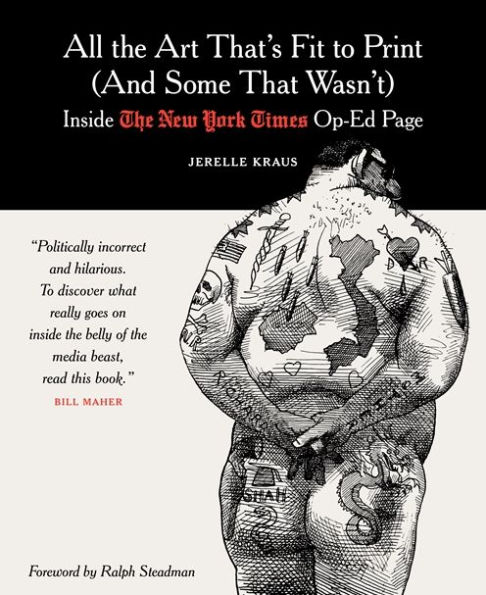
All the Art That's Fit to Print (And Some That Wasn't): Inside The New York Times Op-Ed Page
280
All the Art That's Fit to Print (And Some That Wasn't): Inside The New York Times Op-Ed Page
280Paperback
-
PICK UP IN STORECheck Availability at Nearby Stores
Available within 2 business hours
Related collections and offers
Overview
Jerelle Kraus, whose thirteen-year tenure as Op-Ed art director far exceeds that of any other art director or editor, unveils a riveting account of working at the Times. Her insider anecdotes include the reasons why artist Saul Steinberg hated the Times, why editor Howell Raines stopped the presses to kill a feature by Doonesbury's Garry Trudeau, and why reporter Syd Schanburg—whose story was told in the movie The Killing Fields—stated that he would travel anywhere to see Kissinger hanged, as well as Kraus's tale of surviving two and a half hours alone with the dethroned peerless outlaw, Richard Nixon.
All the Art features a satiric portrayal of John McCain, a classic cartoon of Barack Obama by Jules Feiffer, and a drawing of Hillary Clinton and Obama by Barry Blitt. But when Frank Rich wrote a column discussing Hillary Clinton exclusively, the Times refused to allow Blitt to portray her. Nearly any notion is palatable in prose, yet editors perceive pictures as a far greater threat. Confucius underestimated the number of words an image is worth; the thousand-fold power of a picture is also its curse.
Op-Ed's subject is the world, and its illustrations are created by the world's finest graphic artists. The 142 artists whose work appears in this book hail from thirty nations and five continents, and their 324 pictures-gleaned from a total of 30,000-reflect artists' common drive to communicate their creative visions and to stir our vibrant cultural-political pot.

Product Details
| ISBN-13: | 9780231138253 |
|---|---|
| Publisher: | Columbia University Press |
| Publication date: | 09/04/2012 |
| Pages: | 280 |
| Sales rank: | 1,035,527 |
| Product dimensions: | 8.90(w) x 10.90(h) x 1.00(d) |
| Age Range: | 18 Years |
About the Author
The New Yorker and the New York Times Magazine have published Kraus's writing, including an "On Language" column that subbed for William Safire. Fluent in four languages, she was educated at Swarthmore and Pomona colleges and at l'École des Beaux-Arts in Paris. She received an MA from the University of California, Berkeley, and a Fulbright scholarship to Munich. Her Web site is jerellekraus.com.
Table of Contents
List of IllustrationsAcknowledgments
Prologue
Origins
The Seventies
The Eighties
The Nineties
The Aughts
Notes
Index
What People are Saying About This
To discover what really goes on inside the belly of the media beast, read All the Art That's Fit to Print. The "Some That Wasn't" are never-published illustrations censored by Times poobahs and revealed here for the first time. Jerelle Kraus's juicy tales include clashes with tyrannical editor Howell Raines over imagery he erroneously viewed as politically incorrect or sexual and a hilarious story of meeting Richard Nixon—behind an unmarked door after a secret knock—who wanted the original of her drawing of him and Brezhnev. In today's world of thought crimes, All the Art is must reading.
The pages of this book are illuminated by the results of Kraus's love affair with that remarkable editorial space in the Times.
At first sight, the art of the Op-Ed page baffled. An intelligent reader might have guessed that the Times editors were locking their writers in one room and their artists in another, giving them the same assignments, then joining their words and pictures in editorial matrimony. Like many novel ideas, this approach first struck many as a mistake. Yet within a few years, the 'mistake' had spread to publications around the world, and as the novelty became commonplace, readers came to accept that pictures don't have to illustrate; they can stand on their own. The Op-Ed page was an experiment in form and content. Unlike the gorgeous color illustrations that appeared in glossy magazines, our artwork was defined by short deadlines, low budgets, and simple reproduction. This discipline taught us to whittle our imagery down to sharp points. We let authors dissect their subjects, stretching thought out in time, while we compressed thought into space.
All the Art That's Fit to Print (And Some that Wasn't) is a fascinating display of the social and political events that have shaped the last third of a century, brought to life with powerful graphic images that persist in the memory.
Among its other innovations, the New York Times Op-Ed page has given us the elegant visual jazz of artists set free in a parallel universe, a monochromatic dreamscape where language is banished, allegory rules, and Dada collides with Pop. Kraus serves up the best of these excursions, including, happily, those that went too far.
